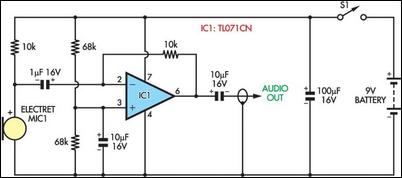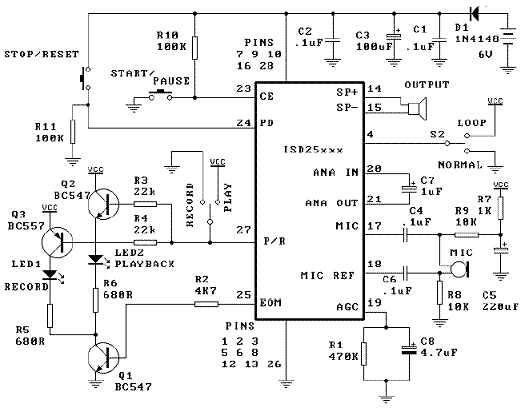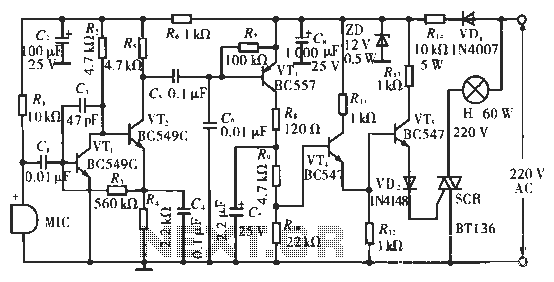
Room Recorder

A wife was working on a doctoral dissertation that involved fieldwork, specifically personal interviews in various settings. The challenge was to find a suitable technical solution for recording these interviews. Passing a tape recorder or microphone back and forth was deemed awkward, and clipping wired microphones to interviewees did not promote an informal atmosphere. Radio microphones were considered too expensive. After some consideration, a "Room Recorder" was developed, which is an add-on microphone preamplifier circuit designed for use with a tape recorder. Although the circuit may not be entirely original, it has yielded high-quality results over a year of interviews and could be beneficial for others engaged in similar work. The preamplifier connects to a Sony Cassette-Corder (or any similar device) via a long, shielded microphone cable and is positioned centrally in the room or on a bench. The circuit is capable of picking up even the faintest whispers, so background noise must be taken into account when selecting a location. A 2-terminal electret microphone captures the sound, which is subsequently amplified by a TL071CN low-noise operational amplifier. It is important to note that the negative terminal of the microphone is connected to its case. Negative feedback is introduced to the inverting input through a 10 kΩ resistor; adjusting the value of this resistor alters the sensitivity of the circuit. The circuit is powered by a 9V battery for ease of use and quiet operation. The power switch is integrated into the case, and the circuit consumes approximately 2 mA, providing around 10 days of continuous operation from a 9V alkaline battery.
The "Room Recorder" circuit is designed to enhance the quality of audio recordings in interview settings by utilizing a low-noise operational amplifier, specifically the TL071CN, which is known for its high input impedance and low distortion characteristics. The choice of a 2-terminal electret microphone is advantageous due to its compact size and ease of use, making it suitable for discreet placement in various environments.
The connection of the microphone's negative terminal to its case is a standard practice that helps to reduce noise and improve the overall signal quality. The use of a 10 kΩ resistor for negative feedback is critical in setting the gain of the amplifier. By varying this resistor, the user can tailor the sensitivity of the microphone preamplifier to suit different recording environments. A higher resistance value will result in increased gain, making the circuit more sensitive to softer sounds, while a lower value will decrease sensitivity, which may be beneficial in louder environments.
The circuit's power supply design, utilizing a 9V alkaline battery, ensures portability and simplicity, allowing for operation in locations without access to mains power. The estimated operational lifespan of 10 days at a current draw of 2 mA enhances the practicality of the device for extended fieldwork sessions. The integration of a power switch on the case facilitates easy operation, enabling the user to conserve battery life when the device is not in use.
Overall, this microphone preamplifier circuit represents a practical solution for capturing high-quality audio in interview settings, balancing performance with ease of use and portability. Its design considerations make it suitable for researchers and practitioners who require reliable audio recording capabilities in varied environments.My wife was working on a doctoral dissertation and needed to do some field work involving personal interviews in various settings. What would be the best way, technically speaking, to record the interviews To pass a tape recorder or microphone back and forth seemed too awkward and clipping wired microphones to interviewees didn`t make for a parti
cularly informal atmosphere. Radio microphones seemed overly expensive, too. After some thought, I can up with the "Room Recorder", an add-on microphone preamplifier circuit for use with a tape recorder. While I don`t make any great claim to originality for the circuit, it has produced first class results over one year of interviews and might prove useful to anyone doing similar work.
The preamplifier was plugged into a Sony Cassette-Corder (any similar device will work) by means of a long, screened microphone cable and placed in a central location in a room or on a bench. The circuit will pick up every whisper, so background noise should be considered when choosing a location.
A 2-terminal electret microphone picks up the sound, which is then amplified by a TL071CN low-noise op amp. Note that the microphone`s negative terminal is connected to its case. Negative feedback is applied to the inverting input through a 10kO resistor. Increasing the value of this resistor will increase sensitivity, and vice versa. For ease of use and quietness of operation, the circuit is powered from a 9V battery. The power switch is mounted on the case. The circuit draws about 2mA and would therefore give about 10 days continuous service from a 9V alkaline battery.
🔗 External reference
The "Room Recorder" circuit is designed to enhance the quality of audio recordings in interview settings by utilizing a low-noise operational amplifier, specifically the TL071CN, which is known for its high input impedance and low distortion characteristics. The choice of a 2-terminal electret microphone is advantageous due to its compact size and ease of use, making it suitable for discreet placement in various environments.
The connection of the microphone's negative terminal to its case is a standard practice that helps to reduce noise and improve the overall signal quality. The use of a 10 kΩ resistor for negative feedback is critical in setting the gain of the amplifier. By varying this resistor, the user can tailor the sensitivity of the microphone preamplifier to suit different recording environments. A higher resistance value will result in increased gain, making the circuit more sensitive to softer sounds, while a lower value will decrease sensitivity, which may be beneficial in louder environments.
The circuit's power supply design, utilizing a 9V alkaline battery, ensures portability and simplicity, allowing for operation in locations without access to mains power. The estimated operational lifespan of 10 days at a current draw of 2 mA enhances the practicality of the device for extended fieldwork sessions. The integration of a power switch on the case facilitates easy operation, enabling the user to conserve battery life when the device is not in use.
Overall, this microphone preamplifier circuit represents a practical solution for capturing high-quality audio in interview settings, balancing performance with ease of use and portability. Its design considerations make it suitable for researchers and practitioners who require reliable audio recording capabilities in varied environments.My wife was working on a doctoral dissertation and needed to do some field work involving personal interviews in various settings. What would be the best way, technically speaking, to record the interviews To pass a tape recorder or microphone back and forth seemed too awkward and clipping wired microphones to interviewees didn`t make for a parti
cularly informal atmosphere. Radio microphones seemed overly expensive, too. After some thought, I can up with the "Room Recorder", an add-on microphone preamplifier circuit for use with a tape recorder. While I don`t make any great claim to originality for the circuit, it has produced first class results over one year of interviews and might prove useful to anyone doing similar work.
The preamplifier was plugged into a Sony Cassette-Corder (any similar device will work) by means of a long, screened microphone cable and placed in a central location in a room or on a bench. The circuit will pick up every whisper, so background noise should be considered when choosing a location.
A 2-terminal electret microphone picks up the sound, which is then amplified by a TL071CN low-noise op amp. Note that the microphone`s negative terminal is connected to its case. Negative feedback is applied to the inverting input through a 10kO resistor. Increasing the value of this resistor will increase sensitivity, and vice versa. For ease of use and quietness of operation, the circuit is powered from a 9V battery. The power switch is mounted on the case. The circuit draws about 2mA and would therefore give about 10 days continuous service from a 9V alkaline battery.
🔗 External reference





